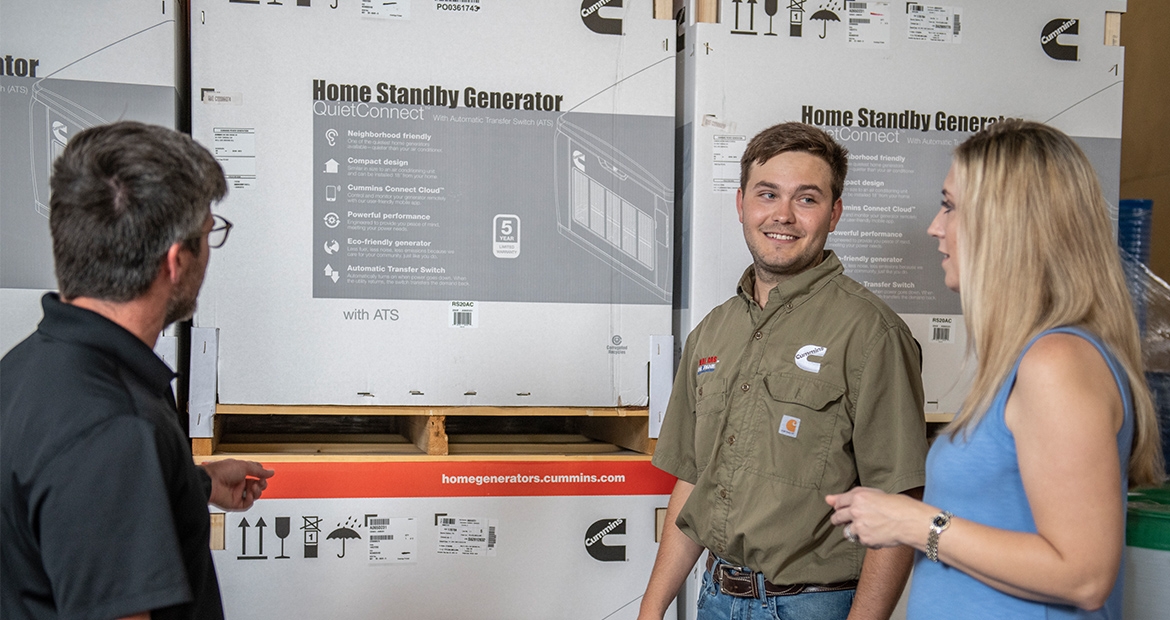How do I calculate what size generator I need?
By Cummins Inc., Global Power Technology Leader

There are several great reasons why you might be considering a standby generator for your home or small business. In the event of a power outage (caused by severe weather, for example), having a standby generator helps ensure ongoing safety and comfort. And in the case of a business, the ability to reduce downtime and maintain operations is a significant advantage.
Standby generators—also known as permanent or whole-house generators—offer reliable and efficient backup power solutions for a wide range of applications. If you’re currently exploring your options, we imagine you have a few concerns. You’re probably looking for a generator that’s sold and serviced by a reputable company, and want to determine the right generator capacity for your needs.
In this article, we’re going to help you answer a key question: “What size generator do I need to run my house or small business in the event of a power outage?” Keep reading for an overview of how to find the perfect Cummins Inc. standby generator for your needs.
What is the rule for generator sizing?
When it comes to understanding generator sizing, one important rule to keep in mind is that the generator needs to be able to power everything requiring electricity, but it also needs to have additional capacity to account for various appliances’ starting wattage. Otherwise, you might find yourself in a situation where your generator simply won’t cut it, potentially leaving your home or small business without the power it needs.
Next, we’ll cover a basic framework for calculating your power needs.
How to Calculate Standby Generator Size
Here’s a simple, three-step process for assessing your needs and priorities, understanding generator sizes, and finding what size generator is going to work best.
Let’s take a look at what this process looks like.
Step 1: Understanding Generator Sizes
Here’s a basic formula for how to calculate standby generator size:
- First, create a list of everything in your home or small business that would need to be powered by the generator in case of an emergency. This should include anything that requires electricity and isn’t something you would want to go without should you lose power. It’s important to not only consider running wattage, but starting wattage as well—since most appliances will require a few seconds’ worth of extra wattage to get started. There are several online sources for determining appliances’ wattage requirements.
- Add together each item’s running watts. When in doubt, err on the side of overestimating wattage requirements since it’s much better to have a little more power available than is needed as opposed to having to adapt to a generator that lacks sufficient power.
- Then, to roughly account for starting wattage, add the single-highest starting watts figure to the total.
- To ensure a margin of safety—and to account for potential future needs—you should multiply that figure by at least 1.25. The resulting number is the minimum generator capacity you should consider.
You can also use our home generator sizing calculator to estimate your power needs.
Step 2: Assessing Your Needs
It’s important to understand your priorities. While getting the right size and type of generator that fits your budget are important, it’s also important to consider how you intend to use the generator.
- Will it need to be capable of maintaining enough power for your home or small business in case of an emergency?
- Do you envision having a permanently-installed generator, or is portability important?
How you answer these questions should help provide context for the next step: exploring generator sizing and zeroing in on the perfect product for your needs.
Step 3: Finding the Right Generator
In addition to the generator size calculator, our online buyer’s guide to home generators is a great starting point for exploring your options. Cummins offers three main types of standby generators suited for a home or small business:
- Permanently-installed 13-20 kW air-cooled home standby generators that can be powered up when needed.
- Permanently-installed 25-150 kW liquid-cooled home standby generators that can be powered up when needed.
- Heavy-duty, gasoline- or propane-powered 9,500-watt dual fuel portable generators that can provide backup power for a home or small business.
Cummins: Reliable and Affordable Standby Power Solutions
At Cummins, we build versatile, high-quality standby generators for homes and small businesses. Don’t let their quietness fool you—they’re powerful and reliable.
When you’re ready to explore your options, you can reach out to request an on-site assessment. One of our authorized dealers will help you assess your needs, evaluate different generator types and capacities, and understand how much a generator might cost to have installed.
Author Profiles

Cummins Inc., Global Power Technology Leader
Cummins Inc., a global power leader, is committed to powering a more prosperous world. Since 1919, we have delivered innovative solutions that move people, goods and economies forward. Our five business segments—Engine, Components, Distribution, Power Systems and Accelera™ by Cummins—offer a broad portfolio, including advanced diesel, alternative fuel, electric and hybrid powertrains; integrated power generation systems; critical components such as aftertreatment, turbochargers, fuel systems, controls, transmissions, axles and brakes; and zero-emissions technologies like battery and electric powertrain systems and electrolyzers. With a global footprint, deep technical expertise and an extensive service network, we deliver dependable, cutting-edge solutions tailored to our customers’ needs, supporting them through the energy transition with our Destination Zero strategy. We create value for customers, investors and employees and strengthen communities through our corporate responsibility global priorities: education, equity and environment. Headquartered in Columbus, Indiana, Cummins employs approximately 70,000 people worldwide and earned $3.9 billion on $34.1 billion in sales in 2024.
Related Topics